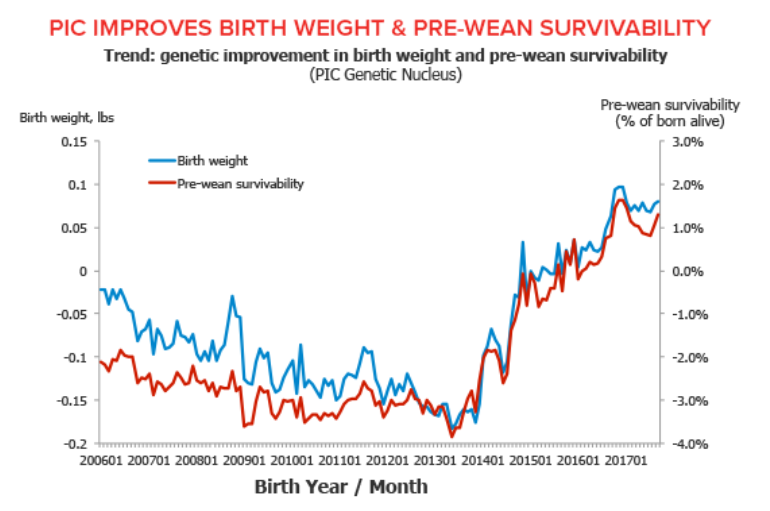



Pig producers worldwide benefit from genetic progress
New genetic techniques are increasing the productivity, efficiency, and yield of PIC pigs at a remarkable rate.The 2013 introduction of Relationship-Based Genomic Selection (RBGS) into PIC’s genetic program has helped to accelerate the growth in commercial profit potential. RBGS has replaced the assumed pedigree-based relationship between animals in the genetic evaluation by the actual genomic-based relationship between animals. This has increased the traditional rate of genetic progress by over 35 percent per year for all traits, product lines, and commercial products. This translates to a profit improvement of $3.50 to $4.00 per pig per year.
In PIC’s genetic farms at the top of the pyramid, we have seen significant advancement in traits that directly impact the efficiency, throughput, and robustness of pork production. This is a direct result of the introduction of RBGS and other on-going investments in technology.
A specific example of this additional value is the impressive change in both total born and average piglet birth weight. PIC has been measuring individual piglet birth weight for a number of years, and has incorporated it into the selection process while implementing RBGS. As a result, the PIC genetic farms have been able to realise an improvement in total born of over 1.5 pigs per litter. Simultaneously, direct selection on individual piglet birth weight has led to an increase of birth weights by over 100 grams per piglet. Total born is a critical measure of success on a sow farm, but if birth weight and survivability of piglets are low, the value of increased total born is minimal. Now that birth weight is also increasing, these additional pigs are more viable and will increase the producers’ productivity and profit potential. Linked to the improvement in birth weight, pre-wean survival has seen a sharp improvement of 0.8 percentage points average per year for the last five years. See Graph 1 for an illustration.

Maternal improvements at the genetic farm level take approximately two to three years to disseminate through a multiplication system to the commercial level. Now, approximately four years after implementation of RGBS, customers are starting to see the impact from this improved rate of gain at their commercial sow farms. The full benefits of these genetic changes in PIC lines are being observed as commercial finisher pigs start reaching market.
PIC maintains a customer database of commercial performance data reproductive results and growing pig performance data in North and South America. The database includes reproductive results from over 710,000 sows and performance data of 6.3 million growing pigs. The performance data are showing strong year-over-year gains. The phenotypic trends of traits ranging from total born to feed conversion to average daily gain are showing trends equal to or greater than the predicted genetic trend.
We share two examples that demonstrate the strong genetic improvement that PIC customers see at the commercial level. Kekén, one of Mexico's largest integrated producers, has used PIC genetics for over 20 years. The Mexican company works with internal multiplication of PIC Camborough sows and is using PIC 337 boars. Genetic gain is turning into commercial improvement as total born per litter has increased from 12.6 pigs in 2013 up to 15.4 pigs in 2017. In the same time period, pigs weaned per sow increased by over 4 pigs per year, from 26.5 up to 30.6 pigs per sow per year (Graph 2). In addition, feed conversion has also improved by over 0.1 from 2.27 in 2014 to 2.16 today while marketing a heavier pig.

Another example of the commercial impact of genetic progress can be observed at Pronaca, a 10,000 sow customer in Ecuador. Pronaca has seen significant improvements in growing pig performance with a daily growth of 991 grams per day versus 922 grams in 2010, and a feed conversion of 2.35 compared to 2.64 in 2010.
For PIC customers, implementation of RBGS and the continued growing investment in industry-leading data capture programs like GNXbred, help deliver the annual improvements necessary in an increasingly competitive industry. Numerous traits, including total born, survivability and efficiency, are improving at an increased rate and create greater benefit for PIC customers.
Our motto “Never Stop Improving” drives PIC every day. Investing in technology and services to deliver robust, predictable commercial-level genetic improvement for our customers is a key part of that mission.








